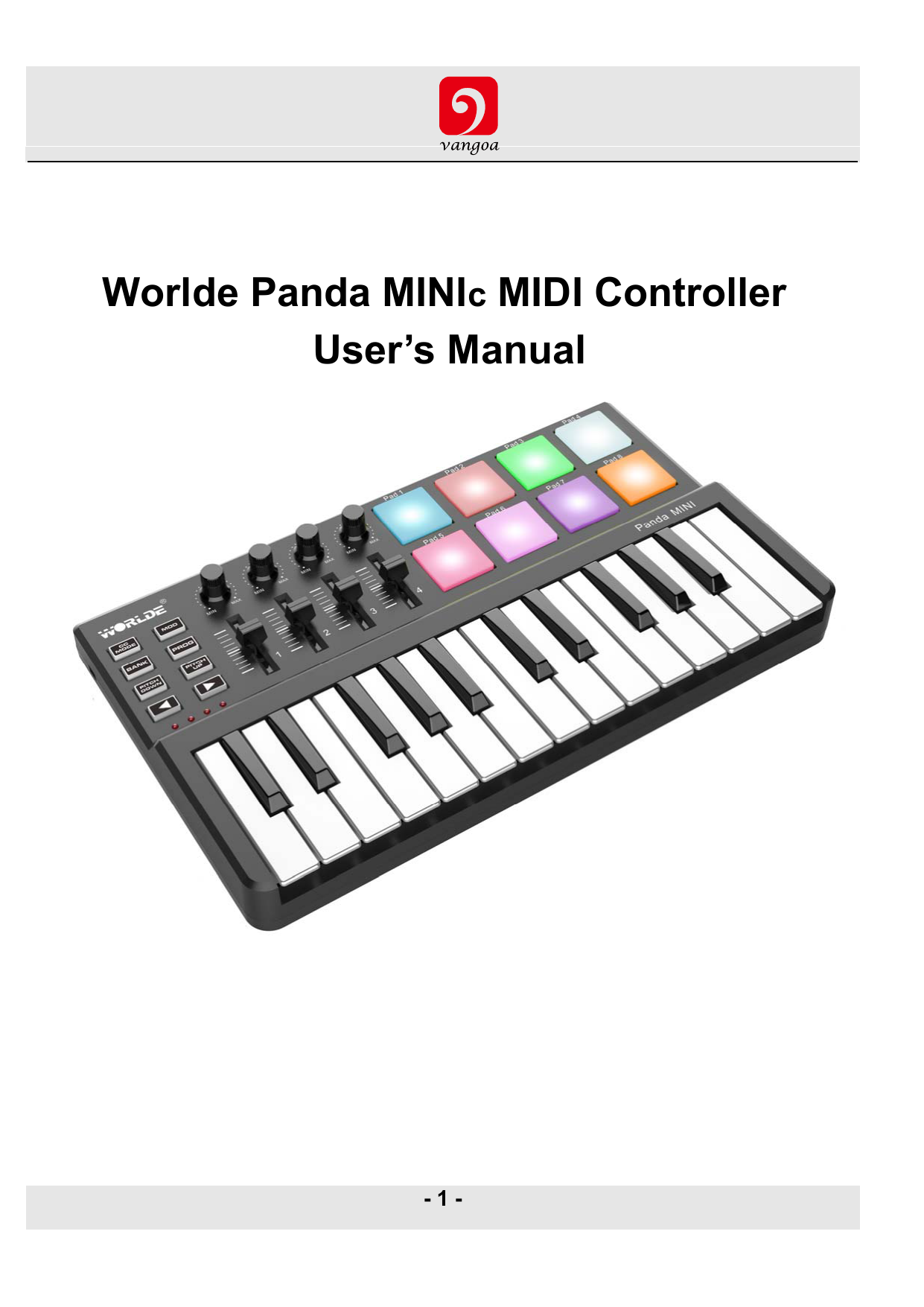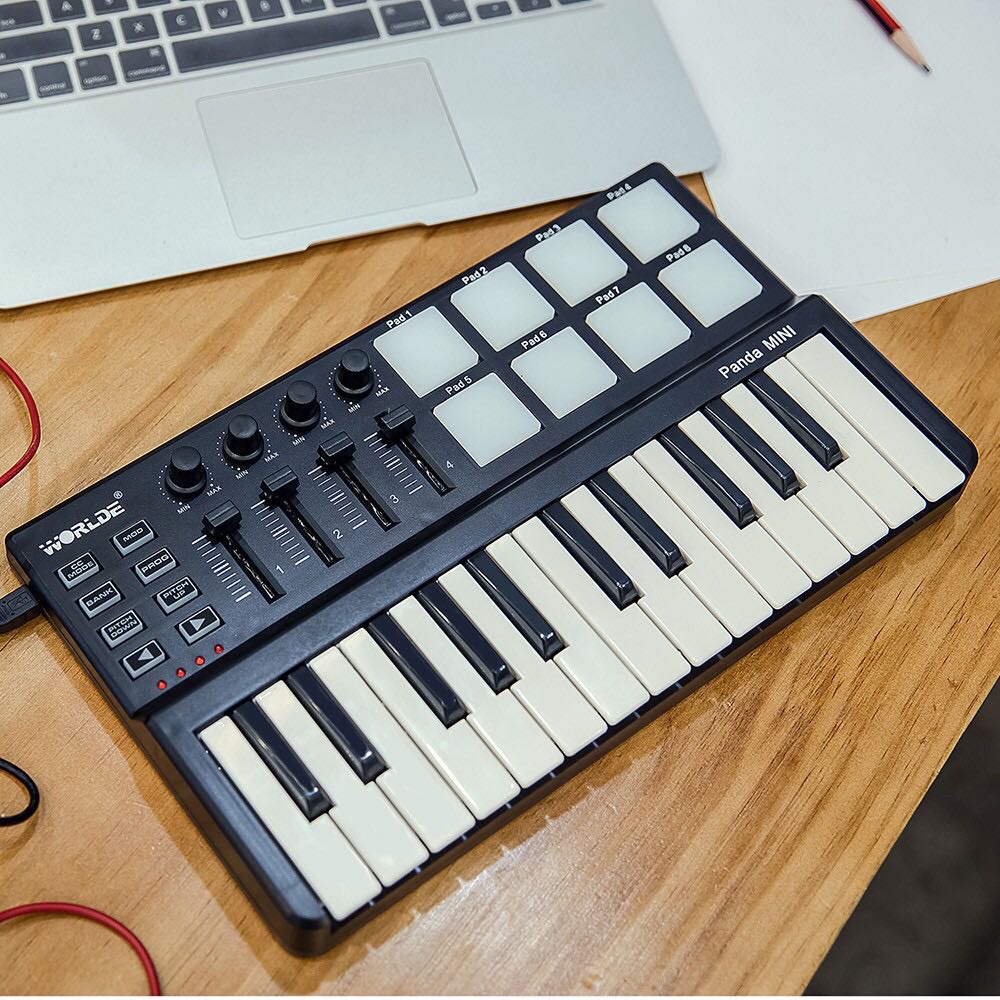Ammoon Worlde Panda mini Portable Mini 25-Key USB Keyboard and Drum Pad MIDI Controller. Easy plug and play connection to your Mac or PC no drivers or power. Akai professional lpk25 - portable usb- powered. Ammoon worlde panda mini portable mini 25- key usb keyboard and drum pad midi controller visit worlde panda mini key manual the ammoon store. Buy worlde panda mini portable 25 key usb keyboard drum pad and midi controller from merchant ragekings. Worlde panda mini is $ 55. 4 out of 5 stars 2 $ 79.
Here you have our curated list of best midi keyboards with drum pads. Each of them comes with different price, style, and design, so you have plenty of options to choose from. Keep reading for our top products review!
In Hurry? Checkout Our Top Pick Of Best Midi Keyboards With Drum Pads.
- Worlde Panda Mini Setup Flexisign Pro 8.6 V2 Crack Common Sense Book Art Williams Pdf Reader Spec Ops The Line For Mac Torrent Gypcrete Installers Massachusetts Phocus 2.7.4 Released For Mac Avid Codec For Mac Phonetray 1.39.
- Only US$47.99, black Worlde Panda mini Portable Mini 25-Key USB Keyboard and Drum - Tomtop.com.
Best Midi Keyboards With Drum Pads
| Rank | Product Name | Score |
|---|---|---|
Akai Professional LPK25 Keyboard Controller for Laptops | ||
9. 5 | ||
Akai Professional MPK Mini MKII – 25 Key USB MIDI Keyboard Controller | ||
Alesis VI61 61-Key USB MIDI Keyboard Controller with 16 Pads | ||
Alesis V49 | 49 Key USB MIDI Keyboard Controller with 8 Backlit Pads | ||
ammoon Worlde Panda mini Portable Mini 25-Key USB Keyboard and Drum Pad MIDI Controller | ||
8. 0 | ||
7 .7 | ||
7. 4 | ||
Alesis V49 | 49-Key USB MIDI Keyboard & Drum Pad Controller |
1. Akai Professional LPK25 Keyboard Controller for Laptops
- 13 inch, slim line laptop performance keyboard with 25 velocity sensitive mini keyboard keys
- Dedicated octave up and down buttons to increase the keyboard to the full melodic range plus a sustain button for expressive performances
- On board arpeggiator steps through chords automatically and generates inspiring melodic ideas quickly
- USB powered and plug and play setup for Mac and PC
- Works with all popular applications including GarageBand, Logic, Sonar, Cubase, Ableton Live, ProTools, Reason, Fruity Loops, Digital Performer, and more
- 4 programmable memory banks for instant recall of mappings for DAWs, virtual instruments, effects and more
2. Korg nanoPAD2 Slim-Line USB MIDI Pads
- Low-profile, multi-function control surface
- New track select and marker advance parameters
- 8 Channels, each with three buttons, one fader, and one knob
- Dedicated transport control section
- Supports numerous software titles including major DAW programs
3. Akai Professional MPK Mini MKII – 25 Key USB MIDI Keyboard Controller
- USB MIDI keyboard controller with 25 velocity-sensitive keys and octave up and down buttons to access the full melodic range – perfect virtual synthesizer control
- Innovative 4-way thumbstick for dynamic pitch and modulation MIDI control, plus a built-in arpeggiator
- No drivers required, USB powered and ultra portable design lets you create anywhere
- 8 backlit velocity-sensitive MPC drum pads with Note Repeat & Full Level for programming drums, triggering samples and controlling virtual instrument / DAW controls
- 8 fully-assignable Q-Link knobs for mixing, tweaking plug-ins and more
- Production software package for Mac and PC included: Akai Pro MPC Essentials, SONiVOX Wobble, and Hybrid 3 by AIR Music Tech
4. Alesis VI61 61-Key USB MIDI Keyboard Controller with 16 Pads
- MIDI Keyboard with 61 full sized, square front, semi weighted keys
- Manipulate plugins and virtual instruments with hands on controls
- 16 velocity sensitive trigger pads with illuminated RGB feedback for beat production and clip launching
- 48 assignable buttons and 16 assignable knobs interface with your music software
- Seamless visual feedback via LED screen and illuminated buttons and knobs
5. Alesis V49 | 49 Key USB MIDI Keyboard Controller with 8 Backlit Pads
- MIDI Keyboard with 49 full sized, velocity sensitive square front keys, perfect for playing Virtual Instruments
- 8 velocity and pressure sensitive back lit pads for beat production and clip launching
- 4 assignable knobs and 4 assignable buttons interface with your music software
- Octave Up and Down buttons let you access the full keyboard range and Pitch and modulation wheels
6. ammoon Worlde Panda mini Portable Mini 25-Key USB Keyboard and Drum Pad MIDI Controller
- 25 velocity-sensitive keys. 8 backlit trigger pads
- 4 MIDI control groups. 4 banks for different settings
- 8 control buttons: CC Mod, Mod, Bank, Prog, Pitch down and Pitch up, Octave down and Octave up
- Plug and Play USB 2.0 cable, no need of driver installation
- USB bus powered - no additional power cable needed
7. Nektar Midi Controller (IMPACT LX25+)
- 25 note velocity sensitive full-size keyboard
- Works with all MIDI music applications
- Smart controller functionality with Nektar DAW Integration for 11 DAWs
- 8 hyper-sensitive LED pads for drum programming
- Fully programmable realtime controls, 5 user presets
- Connect via USB to Windows, OSX, Linux (Ubuntu) or Apple iOS devices
8. LTGEM Travel Hard Carrying Case
- Durable Exterior and Soft Interior
- Sturdy Hand Strap makes transportation easy
- Smooth but strong 360 degree zipper for easy Opening and Closing
- The case features a strong Handle that allows for easy portability on the go
- Dense foam inside to offer a better buffer
- Build-in super quality lining which is an excellent buffer for your Keyboard Controller
9. Akai Professional MPK Mini MKII White

- Limited Edition 25-Key Ultra-Portable USB MIDI Drum Pad & Keyboard Controller with sleek color change
- Compact keyboard controller easily fits backpack and studio production desk
- Powered by USB connection to computer, with free virtual-instrument download packages
- 25-synth-action mini-keys, 8 velocity-sensitive rubber drum pads with two banks, and eight assignable control knobs
10. Alesis V49 | 49-Key USB MIDI Keyboard & Drum Pad Controller
- Perfect building block for music producer needing to control plug-ins and virtual instruments
- 49 full - sized, square-front keys with adjustable sensitivity
- 8 LED - backlit drum trigger pads respond to both velocity and pressure
- 4 assignable knobs, 4 assignable buttons, and Pitch & Mod wheels
- USB - powered with sustain-pedal input
MIDI stands for Musical Instrument Digital Interface. It’s the language spoken by computers and electronic musical instruments. We’ll assume that you’re connecting a MIDI keyboard, although you can use any MIDI instrument. In this guide, “MIDI keyboard” refers to whatever type of MIDI device you are using.
At the very least, you’ll need the following equipment for an operational MIDI system (not including your computer):


- A MIDI keyboard
- Amplifier/speaker or headphones
- Two MIDI cables
- A MIDI interface with appropriate USB cable
Wordle Panda Mini Setup Machine
The last item, a MIDI interface, is a device that translates the signals arriving from the MIDI keyboard into signals that the computer understands, and vice versa. The most basic interfaces require no external power and have ports (jacks) for a single MIDI keyboard; more expensive models have ports for multiple MIDI devices or other features. Most Macs have USB (Universal Serial Bus) ports, a standard that allows users to connect devices to their computers without needing to restart for the devices to become active.
- Place the computer, keyboard, and MIDI interface where you want them. Go ahead and plug in any power cords, but don’t turn anything on yet.
- Plug one end of the MIDI interface cable into the interface (if applicable). Plug the other end into the USB or serial port on the back of your Mac.
- Plug one end of a MIDI cable into the MIDI keyboard port marked MIDI In. Plug the other end into the MIDI interface port marked MIDI Out. Plug the second MIDI cable into the interface port marked MIDI In and the MIDI keyboard port marked MIDI Out. The most common problem encountered by a new MIDI user is improperly connected cables. The trick is to think of the route the music data is taking. The notes you play will leave your MIDI keyboard from the port marked Out, and enter the interface through the port marked In, then on to the computer. Similarly, when the computer plays back your music, the notes go out from the computer to the interface, leave the interface through the port marked Out, and enter your MIDI keyboard through the port marked In. So, although it may seem contrary to common sense, plug the In to the Out and vice versa.
- Turn on all your equipment.
Your MIDI system is now configured. To configure additional settings, see Configuring MIDI in OS X below. When you are ready to continue, move to the next step, Launching and authorizing Finale.
You can use a helper utility already available on your computer to configure your MIDI devices by following these steps.
- Navigate to your hard drive, and choose Application > Utilities > Audio MIDI Setup. Your Mac's Audio MIDI Setup dialog box is displayed. Now, we’ll add new devices.
- Click the MIDI Devices tab (or choose Window > Show MIDI Window. Audio MIDI Setup will search for MIDI hardware and software. After the search, your MIDI interface will appear. If your computer does not recognize the device, consult the documentation that accompanied the device for installation instructions.
- If you are using a controller for MIDI input, drag the outgoing arrow of the MIDI controller to the incoming arrow on the MIDI interface.
- If you are using a sound module for playback, drag the incoming arrow of the sound module to the outgoing arrow on the MIDI interface.
- If you are using a device such as a MIDI keyboard for both input and playback, connect the outgoing arrow on the MIDI device to the incoming arrow on the MIDI interface, and then connect the incoming arrow of the MIDI device to the outgoing arrow of the MIDI interface. Now, to ensure your devices are installed properly on your computer, we’ll test the MIDI setup.
- Click the Test Setup button on the upper right. The cursor changes into two eighth notes.
- Click the DOWN ARROW beneath a device’s icon . Your computer sends a message to your MIDI device. You see the “Out” light illuminate on your MIDI interface and/or a sound played on the MIDI device.
- Click the Internal Speaker icon in the upper right corner of the screen and drag the slider near the top to ensure the volume is up (as shown here).
- Play a note on the external MIDI device. The external MIDI device sends a message to your computer. You see the “In” light on your MIDI interface illuminates and/or hear a beep from your computer’s internal speaker.
- Quit Audio MIDI Setup.
Tip: To playback using General MIDI or a non-General MIDI instrument on your external MIDI keyboard or sound module, see Assigning instruments to MIDI sounds.
| Step 1: Installation | Step 3: Launching and authorizing Finale |
Leave feedback on this topic
Finale 2014 for
Copyright and trademarks
7007 Winchester Circle, Suite 140

Boulder, CO 80301
Leave feedback on this topic
Finale 2014 for
Worlde Panda Mini Software Download
7007 Winchester Circle, Suite 140
Worlde Panda Mini Software Editor
Boulder, CO 80301